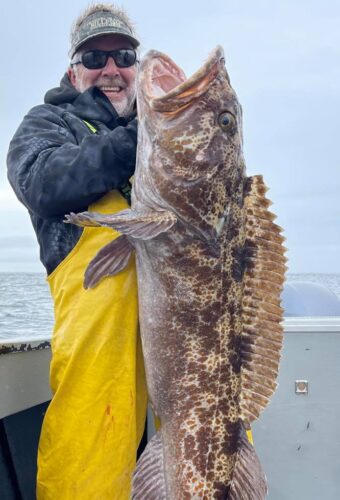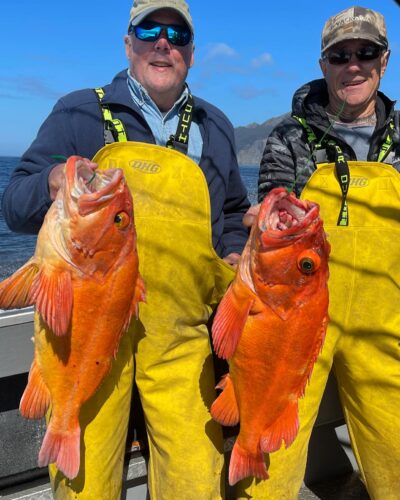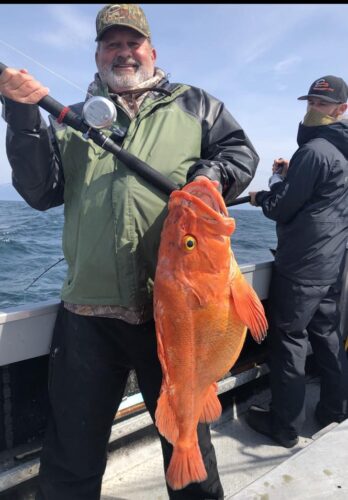
Chase Some (B)Ling In Gulf Of Alaska
The following appears in the June issue of Alaska Sporting Journal:

BY CAL KELLOGG
Picture the scene. We are in the middle of nowhere, a vast marine wilderness in the Gulf of Alaska.
The sea, capable of great violence, is – for the moment – calm and dark under an overcast sky.
A mile to the west the steep slopes of an uninhabited island climb out of the saltwater. The tidal zone is a mix of dark sand beaches and rock covered by a thick blanket of mussels. Beyond the rocks are emerald-green pastures, ultimately giving way to dark timber covering the upper half of the island. Bears live on the island; you’ve seen their round black forms on the beaches and on the grass-covered slopes. They are always eating; always on the move. It’s a stark land with an eat-or-be-eaten economy – both on the steep sloping
islands and beneath the water’s surface. A thousand yards from the boat there is another much smaller island. This one features no beaches and no grass. It’s just a nasty black dagger of lava wearing a cap of dense spruce trees.
Beneath the ocean’s surface a long ridge connects the two islands. If it were not covered with water, you’d see a craggy swayback ridge connecting two rugged peaks. Massive predators patrol the swayback, looking to eat anything smaller and slower than themselves.
Capt. Steve Smith of Captain Steve’s Fishing Lodge is a master at positioning the boat to drift over the swayback. The longer the Alumaweld lingers over the reef, the better the chance of tempting a real trophy. Steve fires a huge jig 150 feet from the boat, engages the reel and hands off the rod to the angler in front of me.
“Swim it; don’t bounce it,” Steve instructs and reaches for my rod to make a long cast.

He’s too late. I’ve already hurled the massive white grub, pinned on a 1-pound jighead upcurrent. My blood is up; I’ve just put a 36-pounder in the box. The jig splashes down 100 feet away. Steve gives me a narrow-eyed look. I’ve broken the rules. He tells us he does the casting and we do the jigging, but I’m not worried. I’ve been fishing with his family for much of my life, and I don’t backlash the reel.
Just then the angler in front of me hooks up. His jig rod is bucking and he’s working the reel hard.
“That’s it; crank on him and work your way around the transom to the downhill side,” Steve instructs.
I feel my jig tick a rock. I pump the bait up off the snag-rich bottom and start slow-rolling it. The adrenaline is flowing. I’m tense. The deckhand just gaffed the fish caught in front of me and I can hear it thrashing wildly on the deck. In my peripheral vision I catch a flash of crimson. It’s a big yelloweye rockfish.
The strike isn’t violent or fast. Instead, it’s subtle – just a feeling of pressure. My brain screams set the hook! But I hesitate for a nanosecond; I’m hedging and trying to ensure the fish has the jig securely.
Steve sees the strike. Steve sees everything. “Set the hook, Cal. Set it now and reel,” he commands.
The spell is broken. I hammer back on the rod and crank hard. I’m into something big. Maybe it’s a halibut. Wepull them off the rocks sometimes. The fish feels huge, but it’s compliant. I work my way around the port corner and past the twin outboards, and presently I’m on the downhill rail, where the current is pushing the fish beyond the boat. Still, the fish keeps coming up.
When the fish realizes it’s in danger it takes a savage run for the bottom. The drag on the jigging reel is set über– tight, but my unseen adversary rips braid off the spool with no problem, as if I’m fishing with a trout rod.
Somewhere short of the bottom, the big fish stops and bursts into a violent series of headshakes as it tries to rid itself of the jig. The thrashing is transmitted up the heavy braid directly to my soul.
Please, please, please don’t spit the hook, I plead in silence while working the reel.
Ten seconds drag by. Time moves slowly at such times, and the fish finally calms down. I haven’t won the fight yet, but I’m gaining. The fish is grudgingly rising in the water column.
It first materializes three rod lengths from the boat as a brown mass; the white jig is showing brightly in the clear, dark water.
I’ve got tunnel vision now. It’s the lingcod of a lifetime: a huge head, sinister eyes and dinner-plate-sized pectoral fins flared, resisting to the end. Steve brushes around me. He grabs the double line with his left hand and drives the steel home with his right. The gaff sinks deeply into the huge ling’s head. Steve times the movement of the boat perfectly. When the boat starts up on a low swell, he lifts the big fish over the rail with a smoothness honed from countless repetitions.
Steve quickly shakes my hand and goes back to work. The words are unsaid, but the understanding is complete. I’ve just landed the fish I traveled to Alaska to chase.
I’d caught a long list of gamefish – many of them certifiably huge – but that big Alaskan lingcod sits atop my personal angling resume. Back at the lodge, the lingcod registers 61 pounds on a certified scale. Catching a fish like that is a memory everyone should experience.

ALASKA’S INCREDIBLE BOTTOMFISHING
For saltwater anglers traveling to the Last Frontier, hard-fighting salmon and “barn door” Pacific halibut (Alaska Sporting Journal, May 2023) typically dominate their fishing fantasies. Those species are definitely exciting, but for the experienced Alaskan saltwater junkie they only represent two of the three marquee saltwater fishing opportunities.
Anglers in the know reflect fondly on lingcod, yelloweye rockfish and black rockfish. All of these fish are great battlers, offer excellent table fare and reach gargantuan proportions in the state’s rich, cold and lightly fished northern waters.
These fish grow slowly and the key to catching trophies is fishing waters few anglers visit. One of Steve’s clients, 20-year-old Robbie Hammond, caught the current world-record lingcod on the same reef where I caught my personal best. Hammond’s incredible ling weighed a massive 82.6 pounds and measured just over 55 inches long.
I saw Robbie’s fish the day after he caught it in Steve’s walk-in freezer. The ling was so freakishly big it didn’t look real. On that trip, the weather never permitted me to get out to Steve’s lingcod grounds. I had to wait until the following year.
Using proper technique is a crucial part of the Alaskan bottomfishing puzzle, but weather is the real common denominator. The best fishing takes place far from boat launches in the archipelago of islands beyond Cook Inlet in the Gulf of Alaska’s treacherous waters.
When the weather is good, these waters are the nirvana of lingcod fishing. When the weather is bad – massive swells and ripping current – fishing isn’t possible, and you could well lose your life trying to navigate these unforgiving bone-chilling waters in smaller crafts. Poseidon controls the temper of the sea. If luck is on your side, you’ll make it out to the lingcod grounds. If it’s not, you’ll have to content yourself with chasing halibut and salmon inside the sheltered waters of Cook Inlet. Yet when the window of opportunity opens and allows you to make the 70-plus-mile runs to the world’s best lingcod reefs, you want to be ready to make the most of it. This means you’ll need to know what to expect, and you need to be prepared to employ proper techniques.

TARGETING LINGCOD THE ALASKA WAY
If you’ve chased lings in California, Oregon or Washington, you might feel confident in terms of technique, but you shouldn’t! I’m a California native and I’ve been chasing Golden State lings for decades. I’ve got fish over 30 pounds, more plus-20s than I can remember, and I’ve literally won thousands of dollars in charter boat jackpots for the big lings I’ve landed. I can tell you from experience, lingcod fishing in Alaska is nothing like lingcod fishing in the Lower 48. If you’re an accomplished Pacific Coast lingcod angler, the best thing you can do when going on an Alaskan trophy hunt is forget everything you know in terms of home- water technique.
Current is the obstacle that sets Alaskan lingcod fishing apart. Even when the current is calm in the ocean off the 49th state, it’s many times stronger than the current experienced along much of the Pacific Coast in the Lower 48.
Down south we like to yo-yo jigs along the bottom and mooch with large live and dead baits. If you try employing those techniques in the ripping Alaskan current, you’ll spend most of your time snagging and breaking off gear.
Speaking of gear, your pet jigging rod is a toy by Alaskan standards and isn’t up to the task. You’ll be using stiff jig sticks spooled with 65-pound-test braid and 3 feet of double line on the business end. The metal bar-style jigs we are so fond of in the south don’t get much play in Alaska because they are very snag- prone. Baitfish- and octopus-imitating swimbaits are king when it comes to hooking big Alaskan lings.
The technique is simple yet alien to most experienced lingcodders. When working rocks in Alaska you don’t want your jig making contact with the bottom. The mussel-studded reefs are extremely sticky and love grabbing tackle. Remember, you are a long way from port and your fishing time is limited. The less time you spend snagged up, the more time you spend fishing and the more fish you are ultimately going to catch.
What you want to do is swim the jig over the rocks. To me, the technique is more like fishing a rainbow-trout-pattern swimbait for monster bass in a California reservoir than what I traditionally view as “lingcod technique.” You simply want to swim your jig through the strike zone and let the lings do the rest.
Sometimes the strike is savage, but usually it’s subtle. All you’re going to feel is a tap, some weight or a bit of pressure. When you feel anything out of the ordinary, swing and reel, because the lings will spit the jig when they sense it’s artificial. Notice I said swing and reel. Don’t hesitate reeling, because if you do hook a fish and it gets slack, it will often headshake and toss the jig.
When some anglers fight a big ling, they like to pump the rod upward and reel down. This method certainly works, but I prefer to keep the rod tip elevated at about 45 degrees and smoothly crank the reel. This approach ensures the line stays tight. With the pump-and-reel approach it’s too easy to give the fish slack, and when slack develops, the fish has a good opportunity to toss the lure.

BONUS BOTTOM DWELLERS
While lingcod are 100 percent the target when working jumbo swimbaits, you will likely cross paths with some other exciting gamefish. Pacific halibut are always a possibility at the lingcod grounds. They aren’t as thick around the rocks as they are on the sandbars and gravel flats inside Cook Inlet, but when you tempt a halibut out here, they are often big fish weighing 50-plus pounds.
The other glamour species lurking among the rocks are yelloweye rockfish. These long-lived bottom dwellers are bright red in color and provide snow- white filets. A decent yelloweye runs 10 to 12 pounds, while a big one tops 20 and a trophy exceeds 25.
Tiger rockfish are often present on the ling grounds too. These crimson- red battlers accented with vertical black bands don’t get as large as yelloweyes, but they are a special kind of cool. I’d dreamed of landing a good-sized tiger for years, and now a beautiful 12-pounder I pulled out of the gulf resides on the wall of my office.

THE GULF IS GREAT
Alaska is an amazing land of mountains and rivers, meadows and dense timber, calm bays and violent seas. The Alaskan wilderness is awe-inspiring, to be sure.
The islands of the gulf where you seek out lings are indeed a special place. They feature beaches seldom walked by humans, where black bears that have never been hunted beachcomb for their next meal.
The landscape is raw and unpolluted, dangerous and remote. If you love the sea and feel the pull of wilderness, you should visit the Gulf of Alaska at least once. It’s a place guaranteed to inspire your imagination and make you feel small and insignificant. And catching some massive bottomfish adds to the special experience. ASJ
Sidebar
BLACK ROCKFISH TIPS
No trip to Alaska’s lingcod grounds is complete without an inshore drift or two in search of black rockfish. Blacks are beautiful fish with large eyes and a mottled black and silver appearance. On light jigging gear they put
up a determined fight and their filets are white and wonderful. You haven’t lived until you’ve cooked up a mess of fish and chips from Alaskan black cod filets.
Black rockfish are typically found in 20 to 40 feet of water lurking amongst the kelp. You hook them on striper-size tackle while working 3- to 4-ounce metal jigs. The average Alaskan black goes 4 pounds, and they range up to 8 or more.
Generally, all you have to do to hook them is drop the jig down 20 or 30 feet and start slowly reeling it up to the surface. These fish will think it’s a small baitfish running for its life and boom! CK



